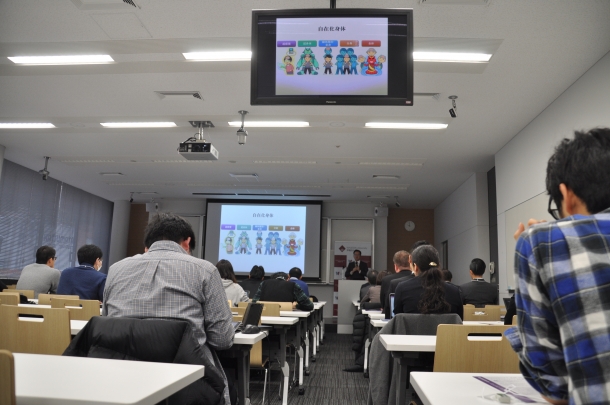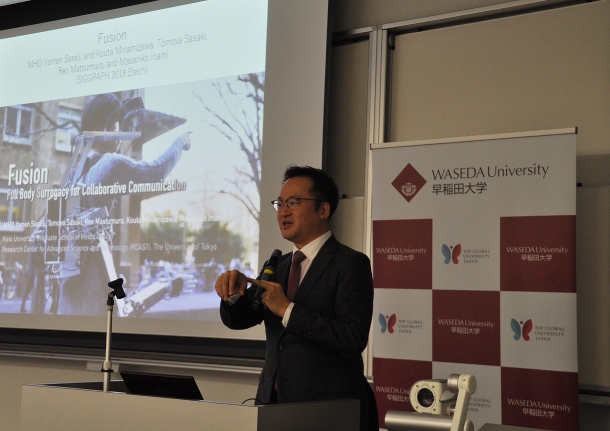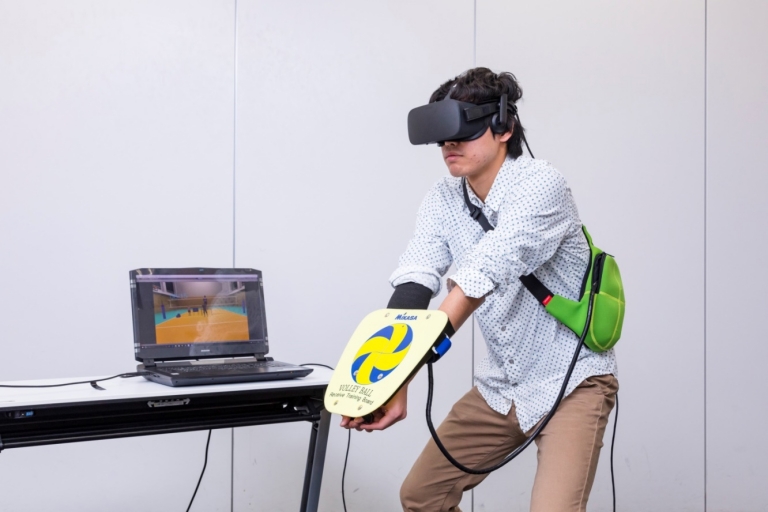Robotics to enrich quality of life
Thu, Jan 16, 2020-
Tags
2019 International Symposium “Innovation through Synergy of Robotics and Sports”
Author Malcom Gladwell proposed in his 2008 book that a total of around 10,000 hours is required to master any skill. The same could be said for athletes, but in recent years, robotics has been helping athletes to improve their performance with more efficiency. For example, a professional Japanese baseball team has incorporated a virtual reality (VR) system into their practice. Also, robots with movements close to that of a human are being created as a synergetic effect.
To explore the questions of how the use of robotics can change sports and how close motions of humanoid robots can come to that of a human, the Health Promotion Model Unit and the ICT & Robotics Model Unit co-organized the international symposium “Innovation through Synergy of Robotics and Sports” on December 7, 2019.

At the Green Computing Systems Research and Development Center, Kikuicho Campus, Waseda University
At the symposium, Professor Masahiko Inami of the Research Center for Advanced Science and Technology at the University of Tokyo gave a presentation on digital cyborgs and superhuman sports.
Due to advancement in information technology and development in robotics, a virtual society is being constructed and various are tasks are becoming automated, helping people to lead their daily lives with more efficiency. However, depending on the situation, having the option to complete a task with any technological assistance is important. To better illustrate, most people would appreciate a robot washing the dishes for them but may not want it to enjoy a meal at their favorite restaurant.
In his presentation, Inami said that humans could perform desired actions if they could become digital cyborgs and adapt their bodies to a given situation and explained that this adaptation is possible with human augmentation, which expands or replenishes human capabilities by the use of technology such as virtual reality and robotics. As examples of digital cyborgs, he referred to the surrogate telepresence robot with supernumerary limbs which encourages collaboration and distance learning of a specific task and the VR system in which a person can acquire the movement of a kamisuki paper-making technique of a living national treasure in just a day.
Human augmentation can help overcome the physical and cognitive restrictions of the human body, and with the Tokyo 2020 Olympic and Paralympic Games coming up, Inami initiated the Superhuman Sports Project. In this project, anyone, regardless of their age and physical capabilities, can enjoy participating or spectating superhuman sport games, such as the power-assisted, omni-directional wheelchair race that competes for drifting skills. He announced that alongside the Olympic and Paralympic Games, the Superhuman Sports Grand Challenge is being planned for August 2020. At the end of the presentation, Inami said, “I hope that someday, the technology used for superhuman sport games will become affordable and become a part of people’s daily lives, even if they don’t play or watch sports, just like tennis shoes or polo shirts.”

Professor Masahiko Inami (Research Center for Advanced Science and Technology, University of Tokyo)
Following Inami, Shinichi Furuya (Researcher and Project Manager, Sony Computer Science Laboratories), Rieko Osu (Professor, Faculty of Human Sciences, Waseda University), Hiroyasu Iwata (Professor, School of Faculty of Science and Engineering, Waseda University), Keita Watanabe (Director, Sports Analytics Lab, Toin University of Yokohama), Nick Whiting (Technical Director, Epic Games), Naomi Okamura (Mizuno Corporation), and Takashi Kawai (Delta Co., Ltd.) also spoke about various topics, such as the use of robotics to enhance the somatosensory perception and motor dexterity of skilled pianists and sports learning assistive robot technology.
Learn more about the guest speakers here
“As robotics to augment human capabilities develops, it will challenge us to become creative and imagine how we can augment ourselves, because otherwise, we won’t be able to use such technologies,” commented Professor Toshimasa Yanai, leader of the Health Promotion Model Unit.
At the closing address, Professor Shigeki Sugano, leader of the ICT & Robotics Model Unit said, “Humans are always looking for ways to physically improve themselves. This pursuit itself is very interesting from a robotics researcher’s perspective, and I hope that the two model units will continue to work together and deepen discussions.”














